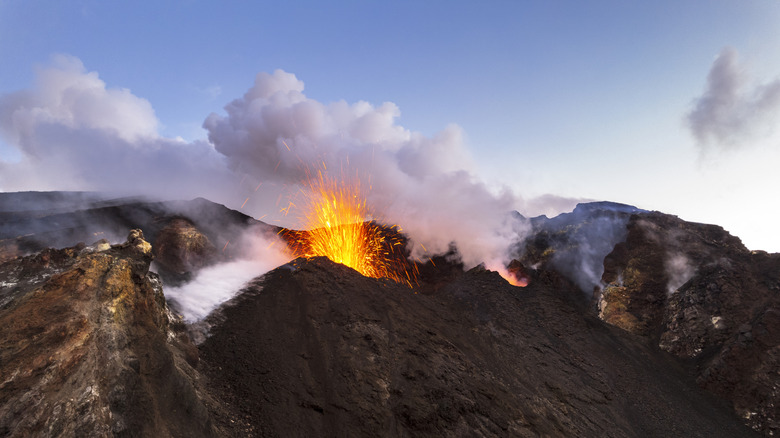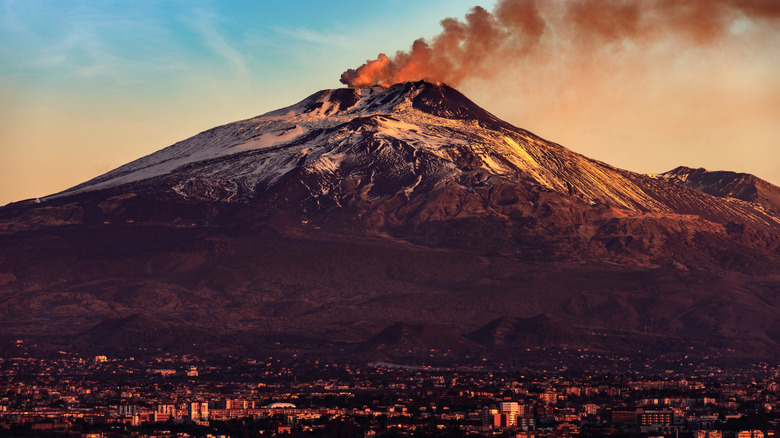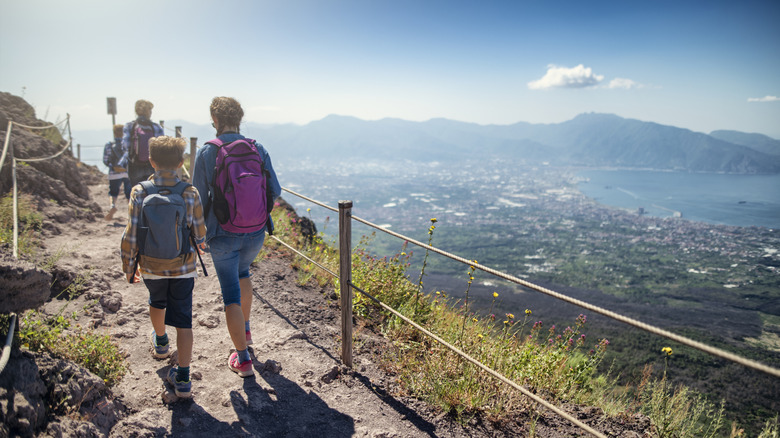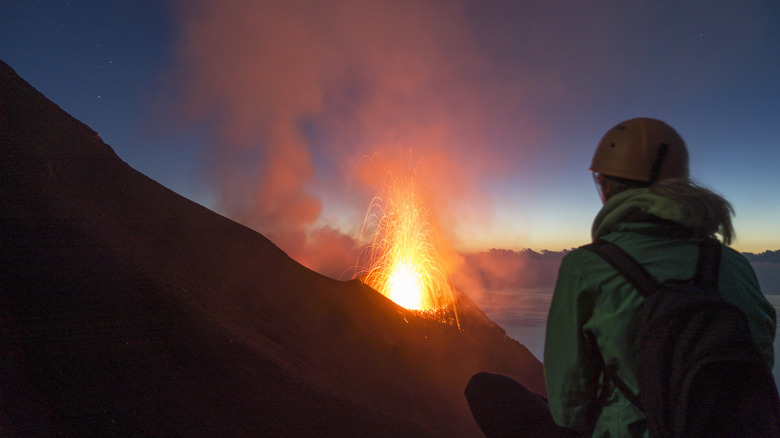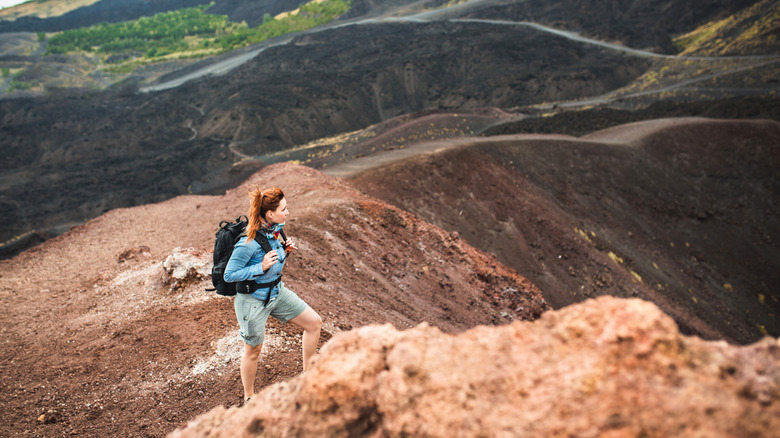What Tourists Need To Know Before Hiking Up Italy's Active Volcanoes
We may receive a commission on purchases made from links.
There's something elemental about hiking an active volcano and staring into the gaping maw of its steaming crater. It's like looking into the very heart of the Earth or standing on the precipice of the Gates of Hell. Due to its location right where the African and Eurasian tectonic plates meet, Italy's most famous active volcanoes — Stromboli, Etna, and Vesuvius — attract thrill-seekers from around the world.
And, they are indeed active. As recently as 2025, Mount Etna puffed out a massive plume of smoke and ash, sending panicked hikers scrambling for safety. Despite the fiery headlines, hiking Italy's restless volcanoes safely is possible, as long as you follow a few rules. First, and most importantly, abide by all trail closures. Even if you've flown from a great distance to summit that last volcano on your bucket list, it's simply not worth the risk.
Next, choose your guide wisely and read reviews not associated with the tour operator before making your selection. Facebook travel groups, like Visit Sicily or Visit Naples, are good places to start, but Reddit and Google Reviews can also yield valuable insights. Look for a guide who is not only knowledgeable about the area but also takes safety precautions seriously and stays up-to-date regarding volcanic activity. Finally, watch your footing. The fire and brimstone may get all the attention, but simple accidents are a greater threat to most hikers. In 2022, a solo hiker got lost on Mount Etna but managed to survive despite freezing conditions.
Mount Etna
With a colossal, 10,900-foot-tall silhouette looming over Sicily, Mount Etna is one of the world's most active volcanoes, with headline-grabbing eruptions happening every few years. According to Greek mythology, Etna is the prison of the serpentine monster Typhon, whose angry outbursts cause the mountain to shake and spew lava.
There are two options for hiking Mount Etna: rugged, uncrowded Etna Nord and the more tourist-friendly Etna Sud. Visitors must hike with a guide to the crater, but are allowed to trek to the upper 4x4 bus drop-off point (Etna Sud) by themselves. Those attempting Etna Sud should catch the bus from Catania's Piazza Giovanni XXIII (check the schedule) or travel with a tour operator to Rifugio Sapienza, the starting point for most Etna tours and the cable car. After soaring over volcanic formations, you'll end up at 8,200 feet, where you can rent warm jackets from local outfitters. From here, depending on volcanic activity, take the 4x4 bus to the summit, so you can conserve your energy for hiking around the upper caldera and taking in the views.
Alternatively, you can hike from Rifugio Sapienza or the upper cable car station; however, the trail isn't well-marked and you can get lost in the clouds. If you value the hike more than the summit, opt for one of the less-traveled routes via the Etna Nord side, like the Serracozzo Path. The best time to hike Etna is late April, May, September, and October, months outside of high season and without snow on the summit.
Mount Vesuvius
Rising 4,203 feet over the Bay of Naples, only a short trip from the Amalfi Coast's enchanting cliffside town, Mount Vesuvius is best known for destroying Pompei and Herculaneum in A.D. 79. Although the last eruption occurred in 1944, the volcano is still classified as active.
You don't need a guide to hike the Gran Cono, aka Trail No. 5, a 2.1-mile, out-and-back route that takes visitors to the massive Vesuvius crater. It's by far the most popular trail in Vesuvius National Park, well-marked and accessible for children and families. The park is free to enter, but you'll need to purchase a ticket to visit the crater. To avoid scams, buy your ticket via the Vesivius National Park website or from reputable tour providers. However, if you want to fully experience the volcanic landscape and are an experienced hiker, attempt the 7.5-mile Valley of Hell trail.
From Naples, the easiest way to reach Mount Vesuvius (and Pompei) is by taking the local Circumvesuviana train to Pompei Scavi – Villa dei Misteri Station (check the schedule). From here, most visitors take a private shuttle to the volcano — beware of aggressive or misleading marketing tactics. However, you can also take the public EAV bus (check the schedule) from Piazza Anfiteatro. Although the park is open year-round, the best time to visit to avoid crowds and trail closures due to bad weather is between March and early June or September and early November.
Mount Stromboli
Situated in Italy's volcanic Aeolian Islands with gorgeous black sand beaches, Mount Stromboli dominates the tiny island of Stromboli, home to only 600 residents. Measuring 3,031 feet, Stomboli is shorter than the other volcanoes on this list, yet its three craters are incredibly active. In fact, there are explosions of various sizes every 10 to 20 minutes! While it doesn't receive the same fanfare as Etna and Vesuvius, those who visit rave about the experience.
The best way to take in Stromboli's splendor is with a guided night hike, which usually departs in the afternoon or early evening and arrives at the viewpoint just before sunset. The glowing orange and red lava against the pitch black earth looks like an ethereal fireworks display, and the sound of the eruptions in the crater is otherworldly. Although you can legally hike up to the 1,300-foot point unassisted, most visitors choose a guide due to the volcano's extreme activity. As recently as 2019, a tourist died during a Mount Stromboli eruption.
To hike Mount Stomboli, you should spend at least one night on the island, but two or three nights will allow you to explore other areas. Before taking the ferry from Milazzo, Sicily, to Stromboli, check the volcanic alert level via the Civil Protection Department and contact your designated tour guide about the current conditions. Guided hikes run from late March to late October, but you'll want to avoid the crowds and high temperatures of July and August.
What do I need for hiking Italy's active volcanoes?
Your packing list will depend on the time of year and which volcano you choose; however, there are a few universal items you should bring no matter what. Pack a water-resistant windbreaker, a fleece jacket, high-carb snacks like trail mix, granola bars, and dried fruit, sturdy hiking boots, a handkerchief for sweat and dust, sunglasses, sunscreen, a flashlight, and, of course, a camera.
You should also bring enough water, about 17 ounces for every mile of hiking, plus extra in case of an emergency. Staying hydrated is also one of the best things to do when you experience altitude sickness on a hike, which might happen during your ascent of Mount Etna.
Even during the warm summer months, it's important to dress in layers. As your sweat dries, you'll start to feel quite chilled, especially once you reach the summits or viewpoints near the craters. However, those attempting to climb Etna or Vesuvius during the chilly winter months should bring a winter jacket, gloves, a knit hat, and anything else necessary for staying warm. Finally, if you plan to hike Stromboli or Etna, consider wearing convertible pants with a zipper at the knee, like the Columbia Silver Ridge Convertible Pant, so you have the option to protect your legs from rocks or cool down.
